Jointed Surrounding Rock Mass Stability Analysis on an Underground Cavern in a Hydropower Station Based on the Extended Key Block Theory
Abstract
:1. Introduction
2. Methodology for Probabilistic Blocks
2.1. Stability Analysis of a Single Block
- (1)
- Stable block, as shown in Figure 1a. If there exists i such that , then the block can be regarded as a stable block.
- (2)
- Free falling block, as shown in Figure 1b. If there exists i such that , then the block can be regarded as a free falling block. The formula for calculating the safety factor can be expressed as follows:where represents the sliding resistance force at the i direction, represents the anchoring efficiency, is the component of cohesion at the g direction, and is the component of the block gravity at the g direction.
- (3)
- Sliding along one face, as shown in Figure 1c. If there exists i such that , and for arbitrary k. The sliding direction of the block can be obtained by or . The formula for calculating the safety factor can be expressed as follows:where and denote the normal and tangential components of gravity to sliding plane i respectively, and are the area and cohesion of plane i, and are the normal and tangential components of the anchoring force to sliding plane i respectively, and and are the normal and tangential components of the shotcrete strength to sliding plane I, respectively.
- (4)
- Double plane sliding, as shown in Figure 1d. If there exists i such that , and for arbitrary k. The sliding direction of the block can be obtained by . The formula for calculating the safety factor can be expressed as follows:where , , and denote the components of block gravity, anchoring force, and shotcrete strength in the direction of the intersection line between plane i and j, respectively.
2.2. Internal Force Transfer of Key Blocks in Different Batches
3. Numerical Analysis: A Case Study
3.1. Engineering Project Profile
3.2. Statistical Analysis of the Rock Joints
3.3. Probabilistic Analysis on Failure Modes
3.4. Surrounding Rock Mass Stability and Results Analysis of the Main Powerhouse
- (1)
- The anchoring force. The corresponding anchoring force in the original design scheme would be converted into anti-sliding force on unit area, then the exposure area in the free excavating surface of the key blocks would be calculated. The product of the anti-sliding force and the exposure area will be the modified anchoring force of the key blocks.
- (2)
- Mechanical behavior of the structural plane. Considering the anchoring effect of the rock bolt on the improvement of mechanical behaviors of the jointed rock mass, the following empirical equation would be adopted:where and are the cohesion and friction angle of the structural plane after applying the support of rock bolt; and are the original cohesion and friction angle; represents the shear strength of rock bolt; is the cross-sectional area of the rock bolt; and are the longitudinal and lateral spacings of the rock bolts; and is a comprehensive empirical coefficient with values between 2.0 and 2.5.
4. Discussion and Conclusions
Acknowledgments
Author Contributions
Conflicts of Interest
References
- Li, Y.; Zhu, W.; Fu, J.; Guo, Y.; Qi, Y. A damage rheology model applied to analysis of splitting failure in underground caverns of Jinping I hydropower station. Int. J. Rock Mech. Min. Sci. 2014, 71, 224–234. [Google Scholar] [CrossRef]
- Li, Y.; Zhou, H.; Zhu, W.; Li, S.; Liu, J. Numerical study on crack propagation in brittle jointed rock mass influenced by fracture water pressure. Materials 2015, 8, 3364–3376. [Google Scholar] [CrossRef]
- Li, Y.; Wang, H.; Zhu, W.; Li, S.; Liu, J. Structural stability monitoring of a physical model test on an underground cavern group during deep excavations using FBG sensors. Sensors 2015, 15, 21696–21709. [Google Scholar] [CrossRef] [PubMed]
- Li, Y.; Zhou, H.; Zhu, W.; Li, S.; Liu, J. Numerical investigations on slope stability using an elasto-brittle model considering fissure water pressure. Arab. J. Geosci. 2015, 8, 10277–10288. [Google Scholar] [CrossRef]
- Li, Y.; Guo, Y.; Zhu, W.; Li, S.; Zhou, H. A modified initial in-situ stress inversion method based on FLAC3D with an engineering application. Open Geosci. 2015, 7, 824–835. [Google Scholar] [CrossRef]
- Li, Y.; Zhou, H.; Zhu, W.; Li, S.; Liu, J. Experimental and numerical investigations on the shear behavior of a jointed rock mass. Geosci. J. 2016, 20, 371–379. [Google Scholar] [CrossRef]
- Wang, H.; Li, Y.; Li, S.; Zhang, Q.; Liu, J. An elasto-plastic damage constitutive model for jointed rock mass with an application. Geomech. Eng. 2016, 11, 77–94. [Google Scholar] [CrossRef]
- Wang, Z.; Li, Y.; Zhu, W.; Xue, Y.; Song, Y. Splitting failure in side walls of a large-scale underground cavern group: A numerical modelling and a field study. Springerplus 2016, 5, 1528. [Google Scholar] [CrossRef] [PubMed]
- Li, Y.; Zhou, H.; Zhang, L.; Zhu, W.; Li, S.; Liu, J. Experimental and numerical investigations on mechanical property and reinforcement effect of bolted jointed rock mass. Constr. Build. Mater. 2016, 126, 843–856. [Google Scholar] [CrossRef]
- Li, B.; Li, Y.; Zhu, W.; Li, C.; Dong, Z. Impact of in situ stress distribution characteristics on jointed surrounding rock mass stability of an underground cavern near a hillslope surface. Shock Vib. 2017, 2017, 2490431. [Google Scholar] [CrossRef]
- Li, Y.; Li, C.; Zhang, L.; Zhu, W.; Li, S.; Liu, J. An experimental investigation on mechanical property and anchorage effect of bolted jointed rock mass. Geosci. J. 2017. [Google Scholar] [CrossRef]
- Warburton, P.M. Vector stability analysis of an arbitrary polyhedral rock block with any number of free faces. Int. J. Rock Mech. Min. Sci. Geomech. Abstr. 1981, 18, 415–427. [Google Scholar] [CrossRef]
- Goodman, R.E.; Shi, G.H. Block Theory and Its Application to Rock Engineering; Prentice-Hall Press: Englewood Cliffs, NJ, USA, 1985; pp. 55–67. [Google Scholar]
- Warburton, P.M. Implications on keystone action for rock bolt support and block theory. Int. J. Rock Mech. Min. Sci. 1987, 24, 283–290. [Google Scholar] [CrossRef]
- Lin, D.; Fairhurst, C. Static analysis of the stability of three-dimensional blocky systems around excavation in rock. Int. J. Rock Mech. Min. Sci. Geomech. Abstr. 1988, 25, 139–147. [Google Scholar] [CrossRef]
- Mauldon, M.; Goodman, R. Vector analysis of keyblock rotations. J. Geotech. Engrgy 1996, 122, 976–987. [Google Scholar] [CrossRef]
- Yarahmadi-Bafghi, A.R.; Verdel, T. The key-group method. Int. J. Numer. Anal. Methods Geomech. 2003, 27, 495–511. [Google Scholar] [CrossRef]
- Noroozi, M.; Jalali, S.E.; Yarahmadi-Bafghi, A.R. 3D key-group method for slope stability analysis. Int. J. Numer. Anal. Methods Geomech. 2012, 36, 1780–1792. [Google Scholar] [CrossRef]
- Firpo, G.; Salvini, R.; Francioni, M.; Ranjith, P.G. Use of digital terrestrial photogrammetry in rocky slope stability analysis by distinct elements numerical methods. Int. J. Rock Mech. Min. Sci. 2011, 48, 1045–1054. [Google Scholar] [CrossRef]
- Kim, B.H.; Cai, M.; Kaiser, P.K.; Yang, H.S. Estimation of block sizes for rock masses with non-persistent joints. Rock Mech. Rock Eng. 2007, 40, 169–192. [Google Scholar] [CrossRef]
- Menéndez-Díaz, A.; González-Palacio, C.; Álvarez-Vigil, A.E.; González-Nicieza, C.; Ramírez-Oyanguren, P. Analysis of tetrahedral and pentahedral key blocks in underground excavations. Comput. Geotech. 2009, 36, 1009–1023. [Google Scholar] [CrossRef]
- Elmouttie, M.; Poropat, G.; Krähenbühl, G. Polyhedral modelling of underground excavations. Comput. Geotech. 2010, 37, 529–535. [Google Scholar] [CrossRef]
- Kulatilake, P.H.S.W.; Wang, L.; Tang, H.; Liang, Y. Evaluation of rock slope stability for Yujian River dam site by kinematic and block theory analyses. Comput. Geotech. 2011, 38, 846–860. [Google Scholar] [CrossRef]
- Fu, G.Y.; Ma, G.W. Extended key block analysis for support design of blocky rock mass. Tunn. Undergr. Space Technol. 2014, 41, 1–13. [Google Scholar] [CrossRef]
- Zheng, J.; Kulatilake, P.H.S.W.; Shu, B.; Sherizadeh, T.; Deng, J. Probabilistic block theory analysis for a rock slope at an open pit mine in USA. Comput. Geotech. 2014, 61, 254–265. [Google Scholar] [CrossRef]
- Carranza-Torres, C.; Fosnacht, D.; Hudak, G. Geomechanical analysis of the stability conditions of shallow cavities for compressed air energy storage (CAES) applications. Geomech. Geophys. Geo-Energy Geo-Resour. 2017. [Google Scholar] [CrossRef]
- Sun, G.; Zheng, H.; Huang, Y. Stability analysis of statically indeterminate blocks in key block theory and application to rock slope in Jinping-I hydropower station. Eng. Geol. 2015, 186, 57–67. [Google Scholar] [CrossRef]
- Sun, G.; Cheng, S.; Jiang, W.; Zheng, H. A global procedure for stability analysis of slopes based on the morgenstern-price assumption and its applications. Comput. Geotech. 2016, 80, 97–106. [Google Scholar] [CrossRef]
- Windsor, C.R.; Thompson, A.G. Reinforcement design for jointed rock mass. In Proceedings of the 33rd U.S. Symposuim on Rock Mechanics, Santa Fe, NM, USA, 8–10 June 1992; pp. 521–530. [Google Scholar]
- Thompson, A.G.; Windsor, C.R. Block formation around excavations using deterministic and probabilistic methods. In Proceedings of the 11th ISRM Congress on Rock Mechanics, Lisbon, Portugal, 9–13 July 2007; pp. 183–186. [Google Scholar]
- Windsor, C.R. Rock reinforcement systems. Int. J. Rock Mech. Min. Sci. 1997, 34, 919–951. [Google Scholar] [CrossRef]
- Thompson, A.G. Stability assessment and reinforcement of block assemblies near underground excavations. In Proceedings of the 5th North American Rock Mechanics Symposium and the 17th Tunnelling Association of Canada Conference, Toronto, ON, Canada, 7–10 July 2002; pp. 1439–1446. [Google Scholar]
- González-Palacio, C.; Menéndez-Díaz, A.; Álvarez-Vigil, A.E.; González-Nicieza, C. Identification of non-pyramidal key blocks in jointed rock masses for tunnel excavation. Comput. Geotech. 2005, 32, 179–200. [Google Scholar] [CrossRef]
- Ministry of Construction of the People’s Republic of China. Chinese National Code for Geotechnical Investigation (GB 50021-2001); Ministry of Construction of the People’s Republic of China: Beijing, China, 2002.
- Lian, M.Y. Stability Analysis of Jointed Rock Mass in the Plant Area of Taishan Pumped Storage Power Station. Master’s Thesis, Shandong University, Jinan, China, 2016. (In Chinese). [Google Scholar]
- Zhu, W.S.; Li, S.C.; Chen, W.Z. Failure Mechanism and Anchorage Effect of Jointed Rock Mass and Engineering Application; Science Press: Beijing, China, 2002; pp. 99–110. [Google Scholar]
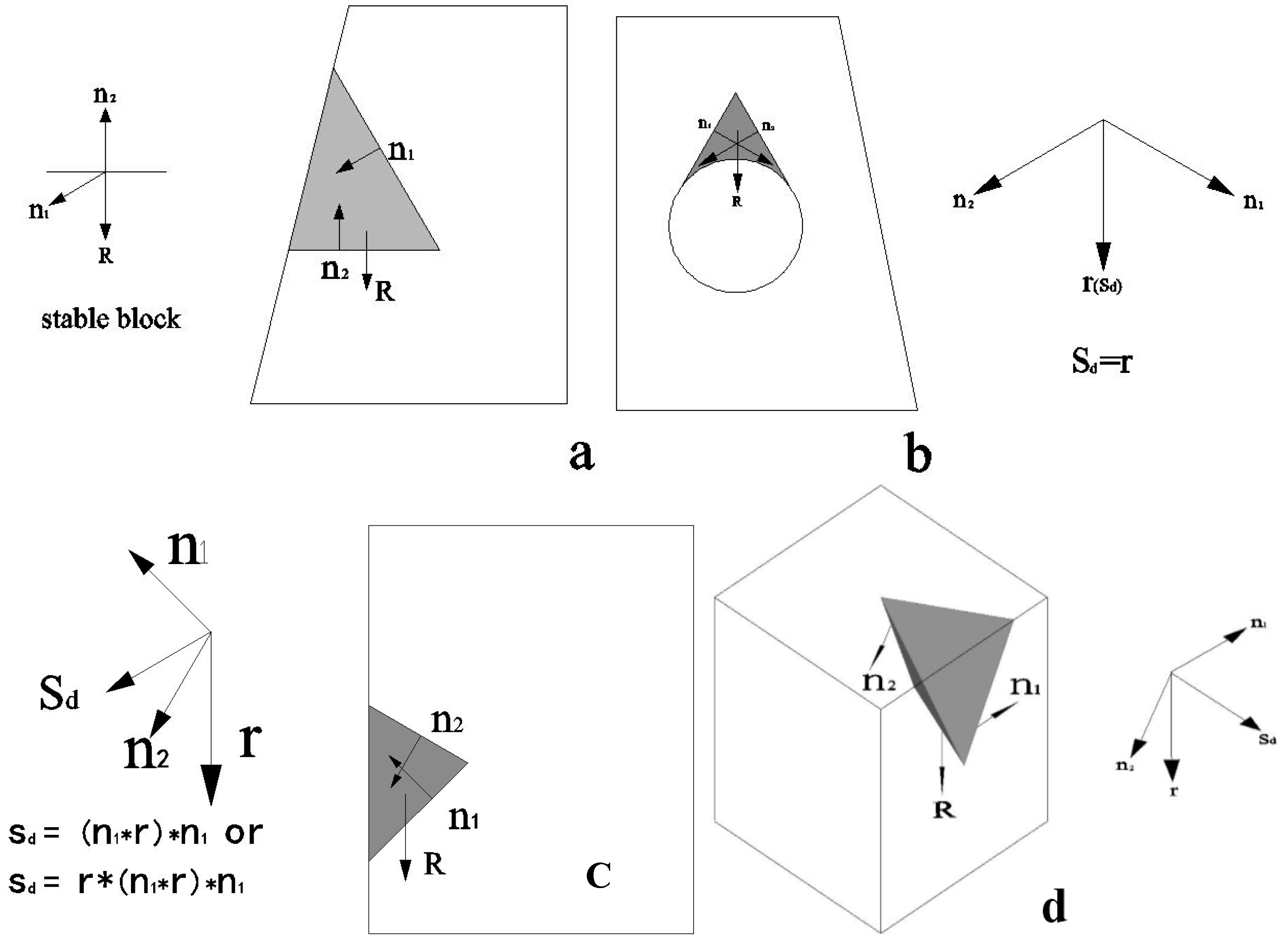
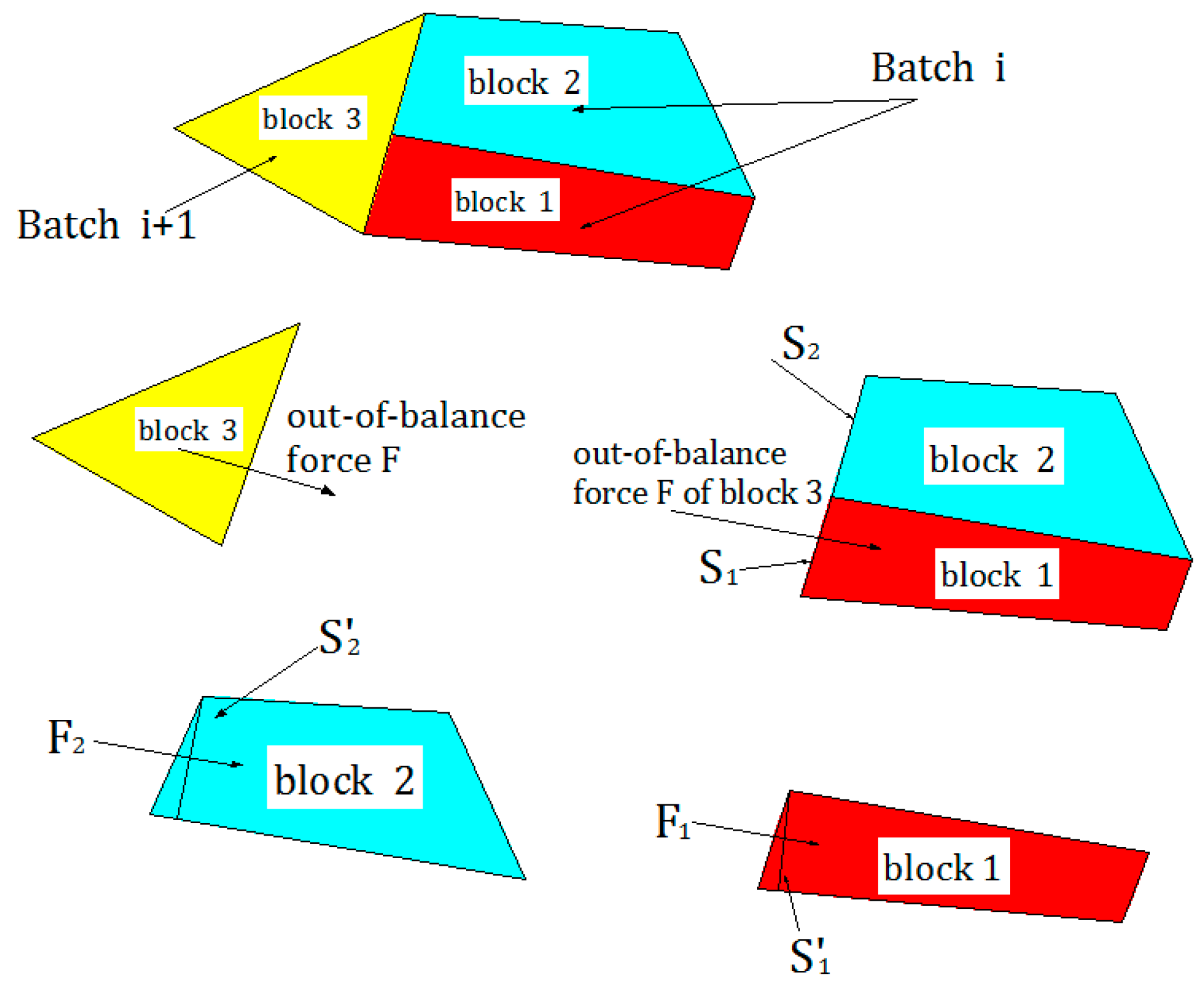
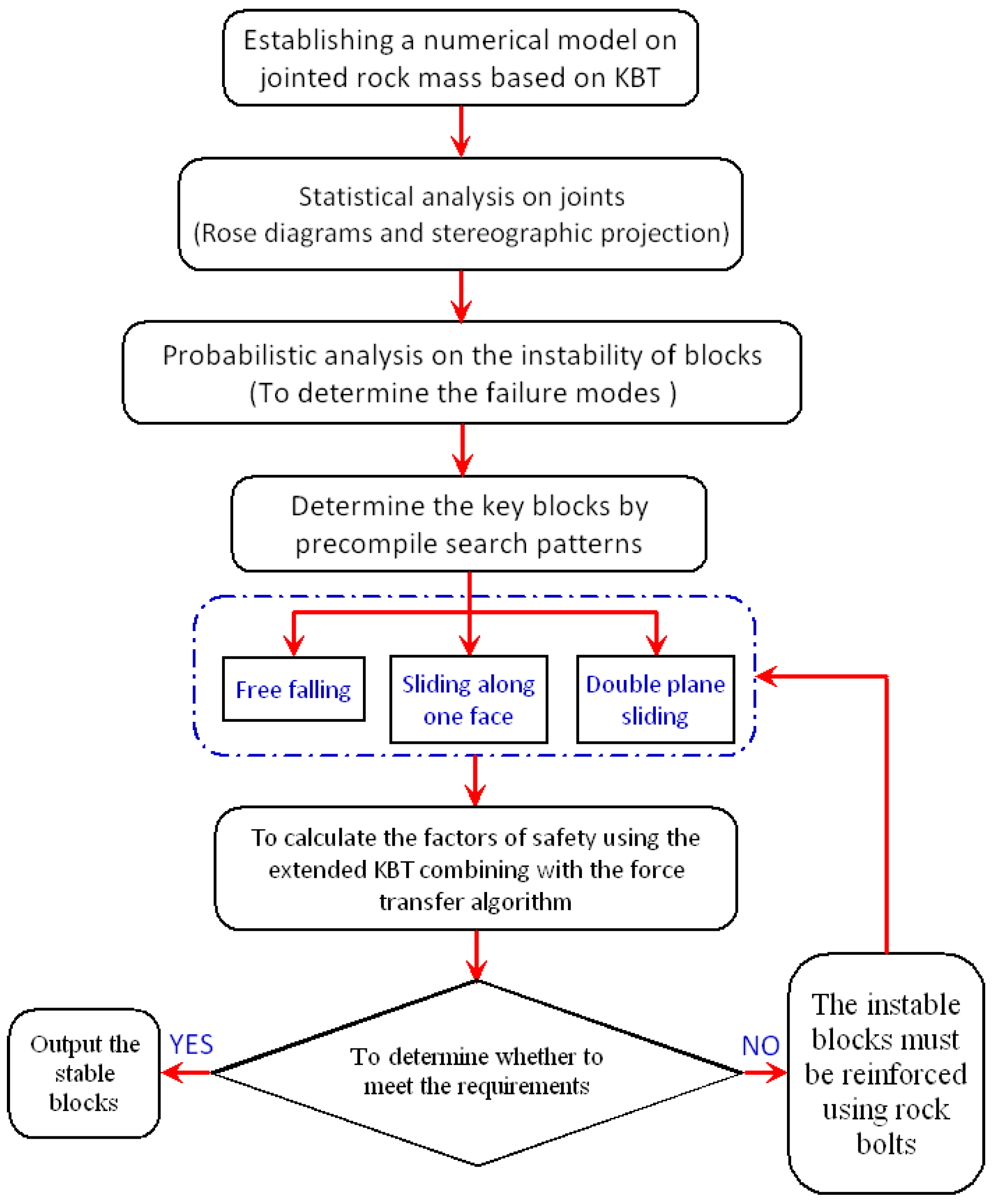
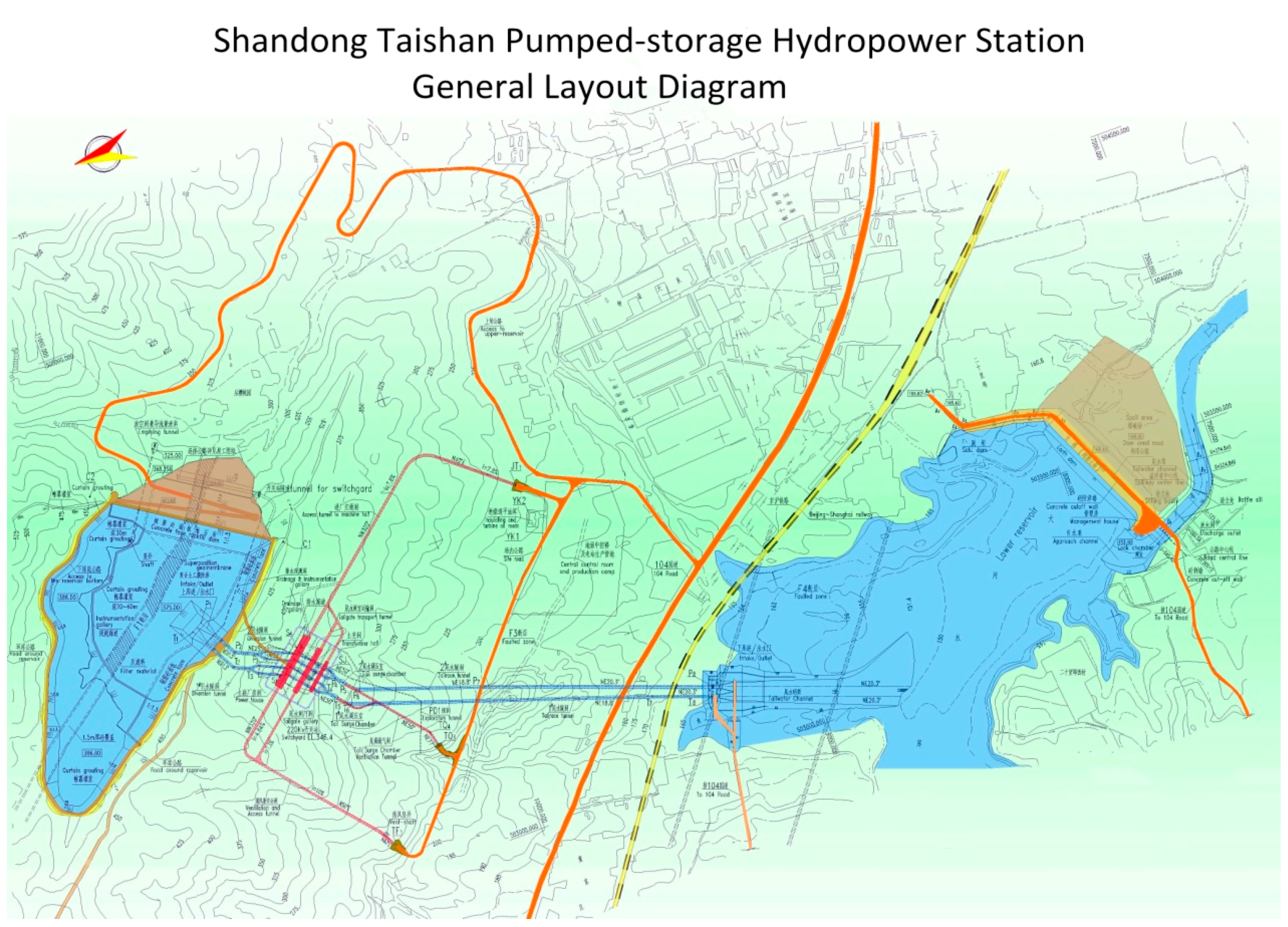
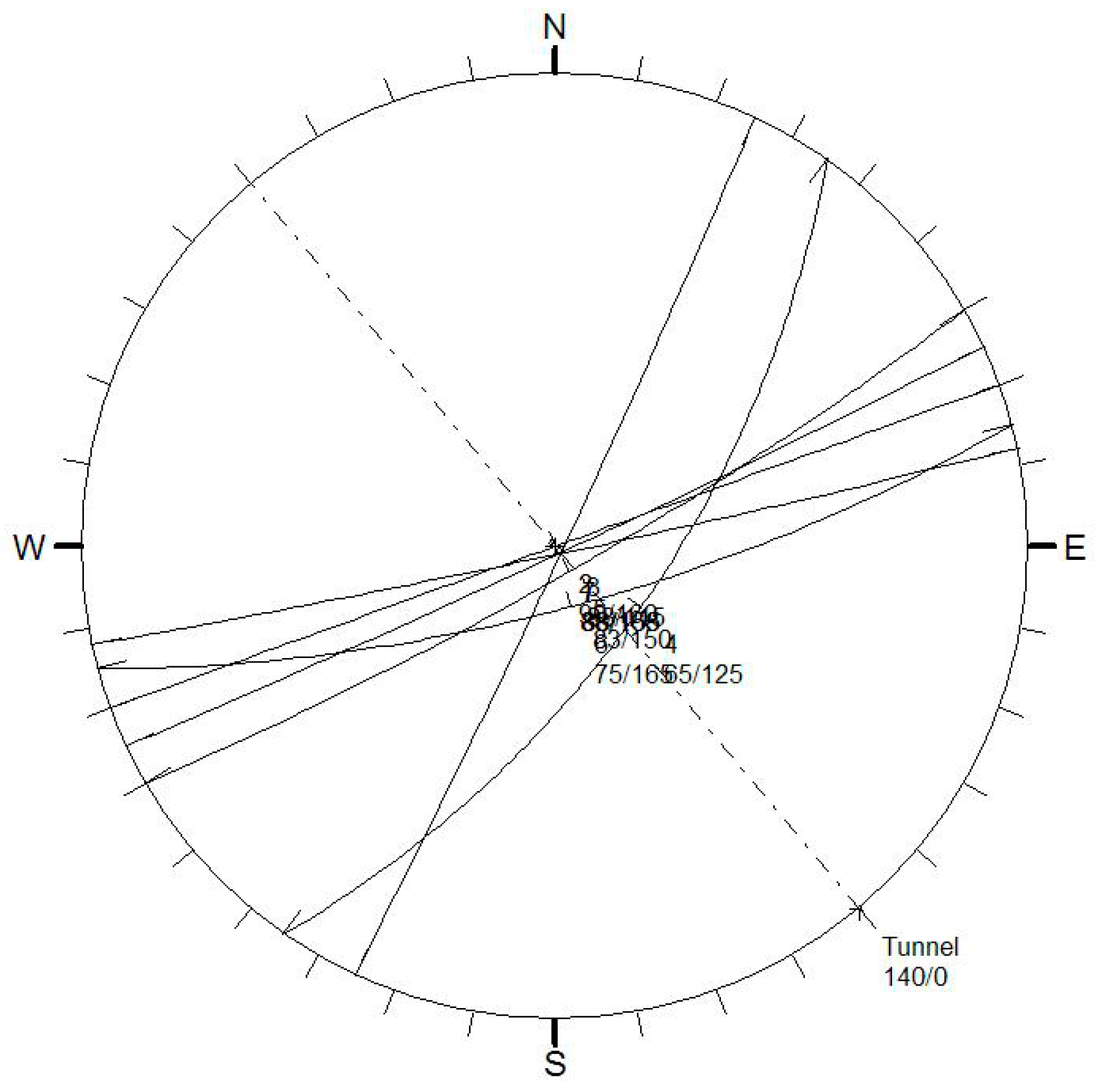
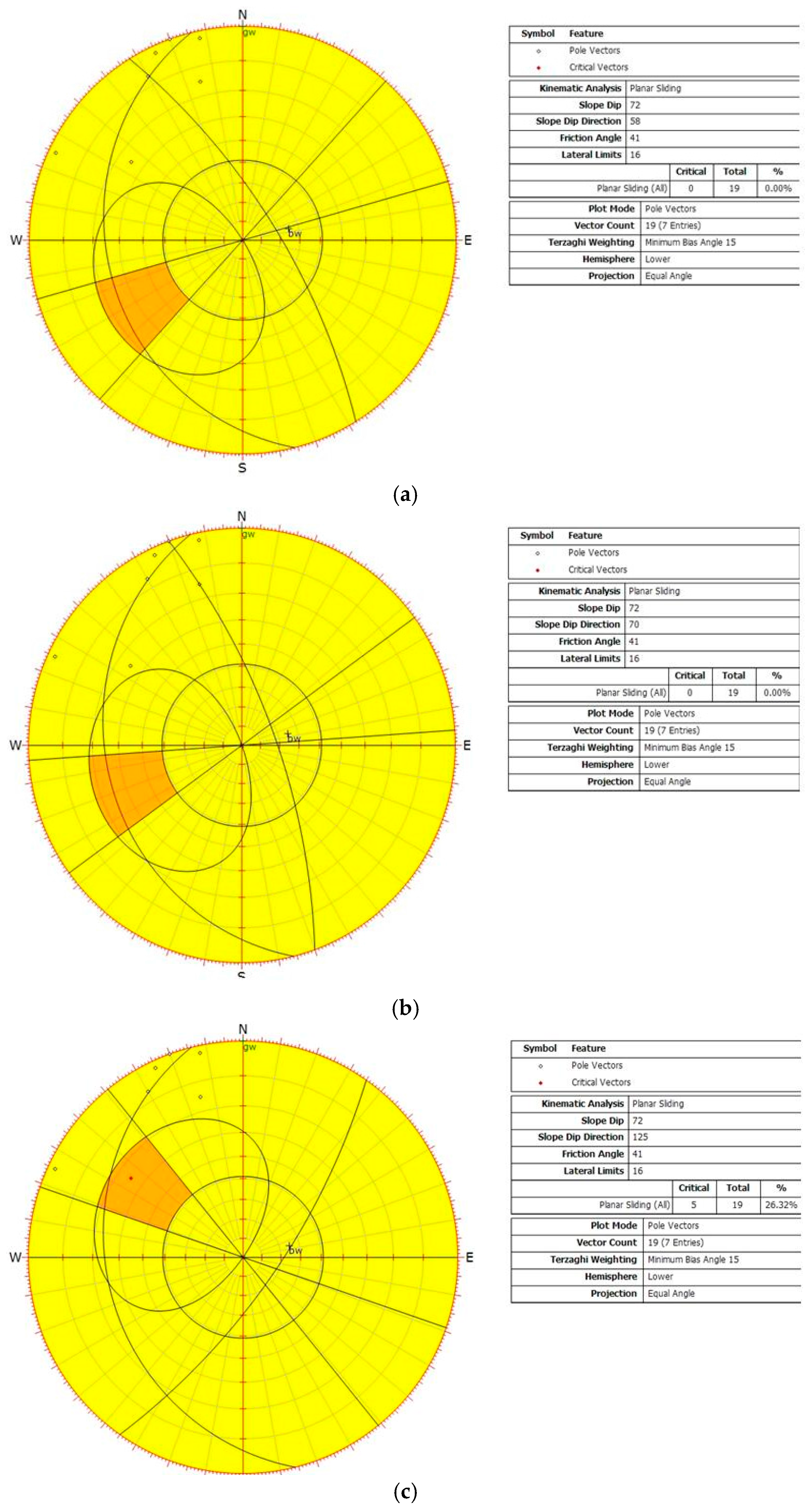
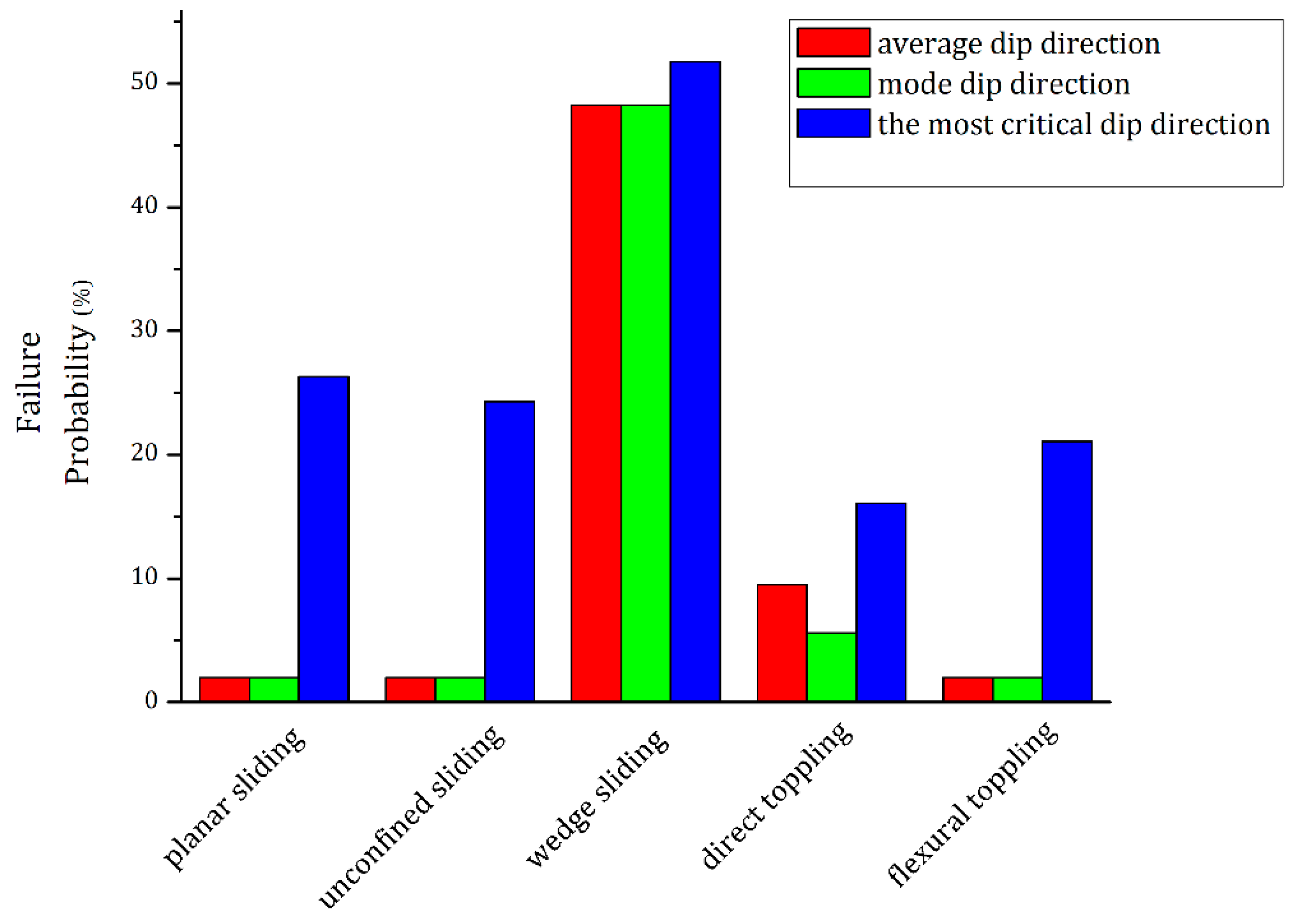
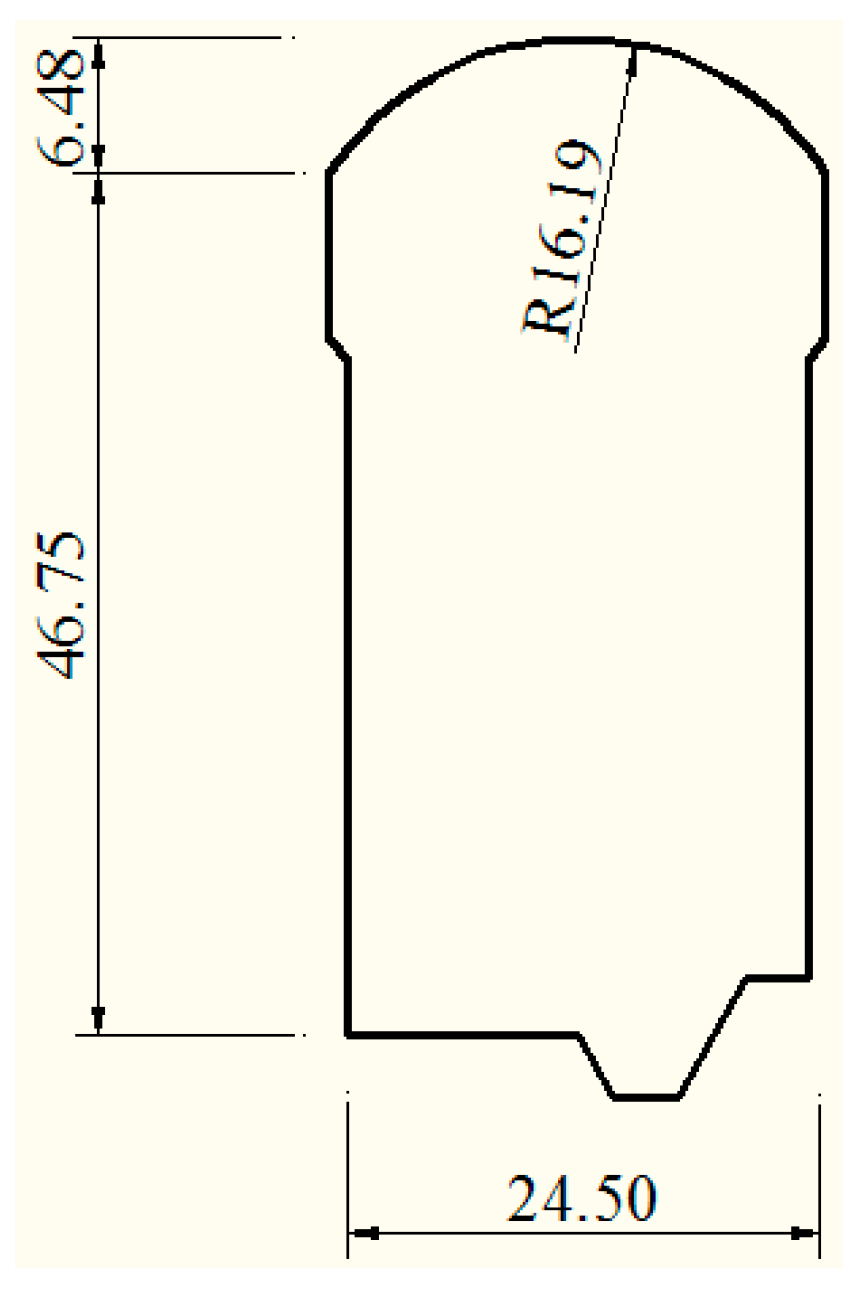
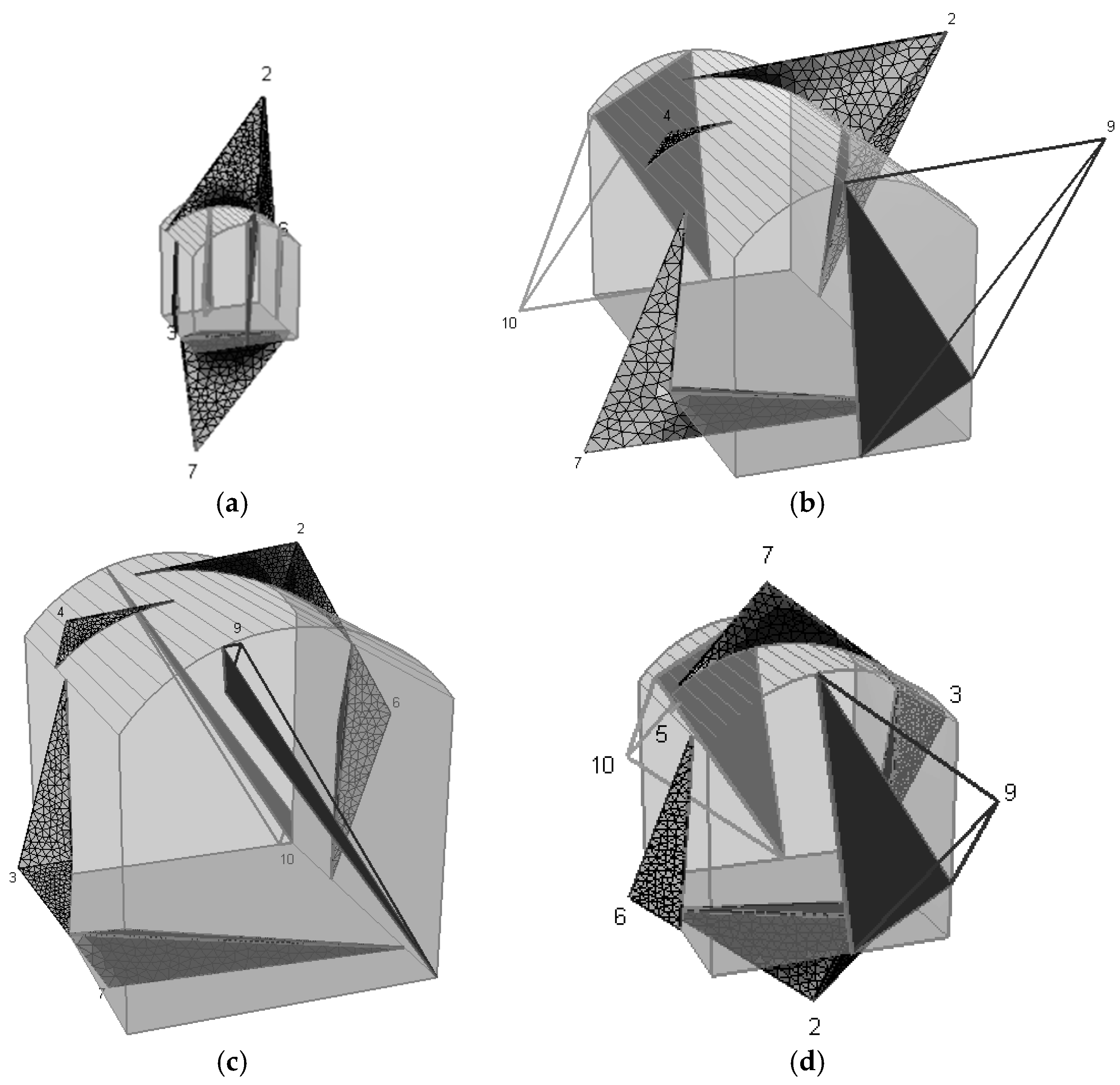
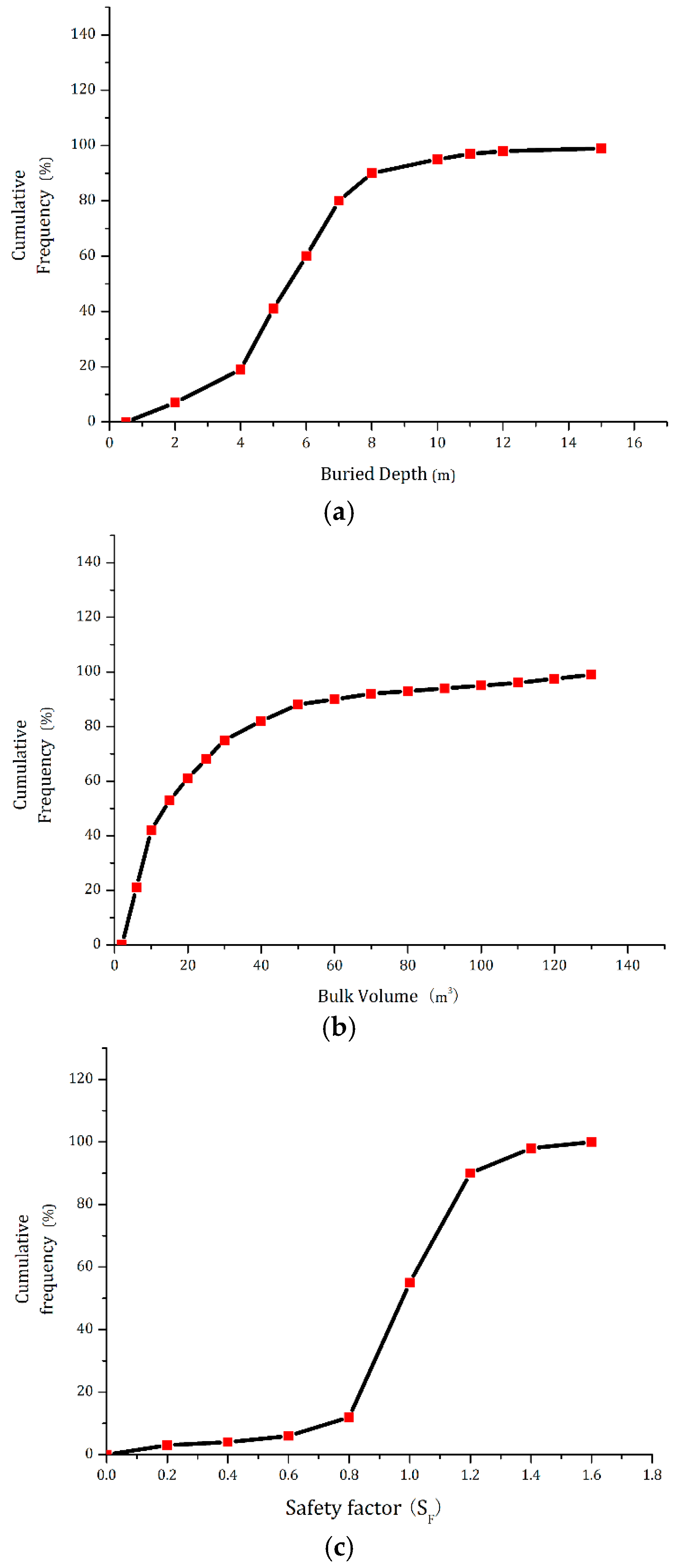
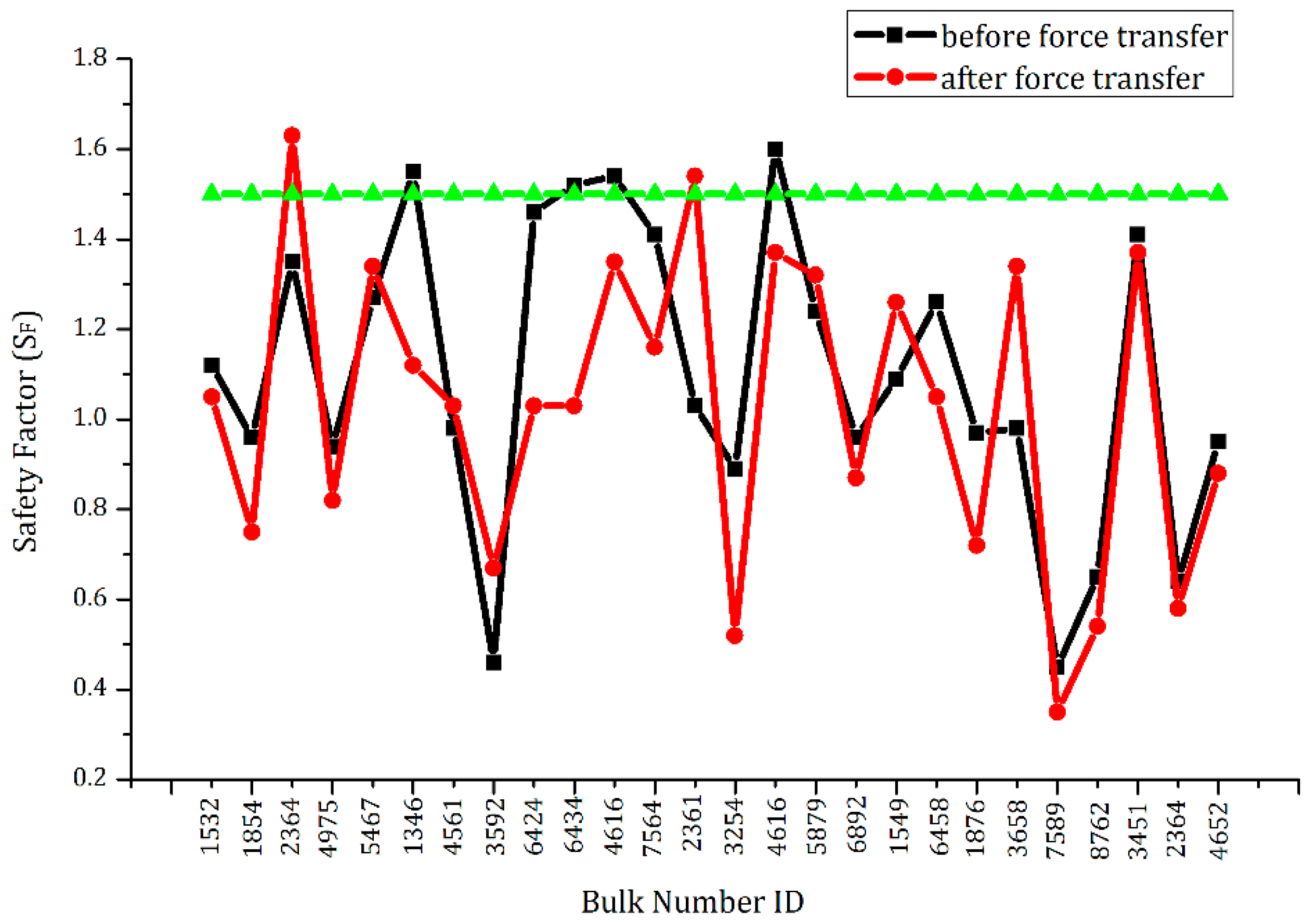

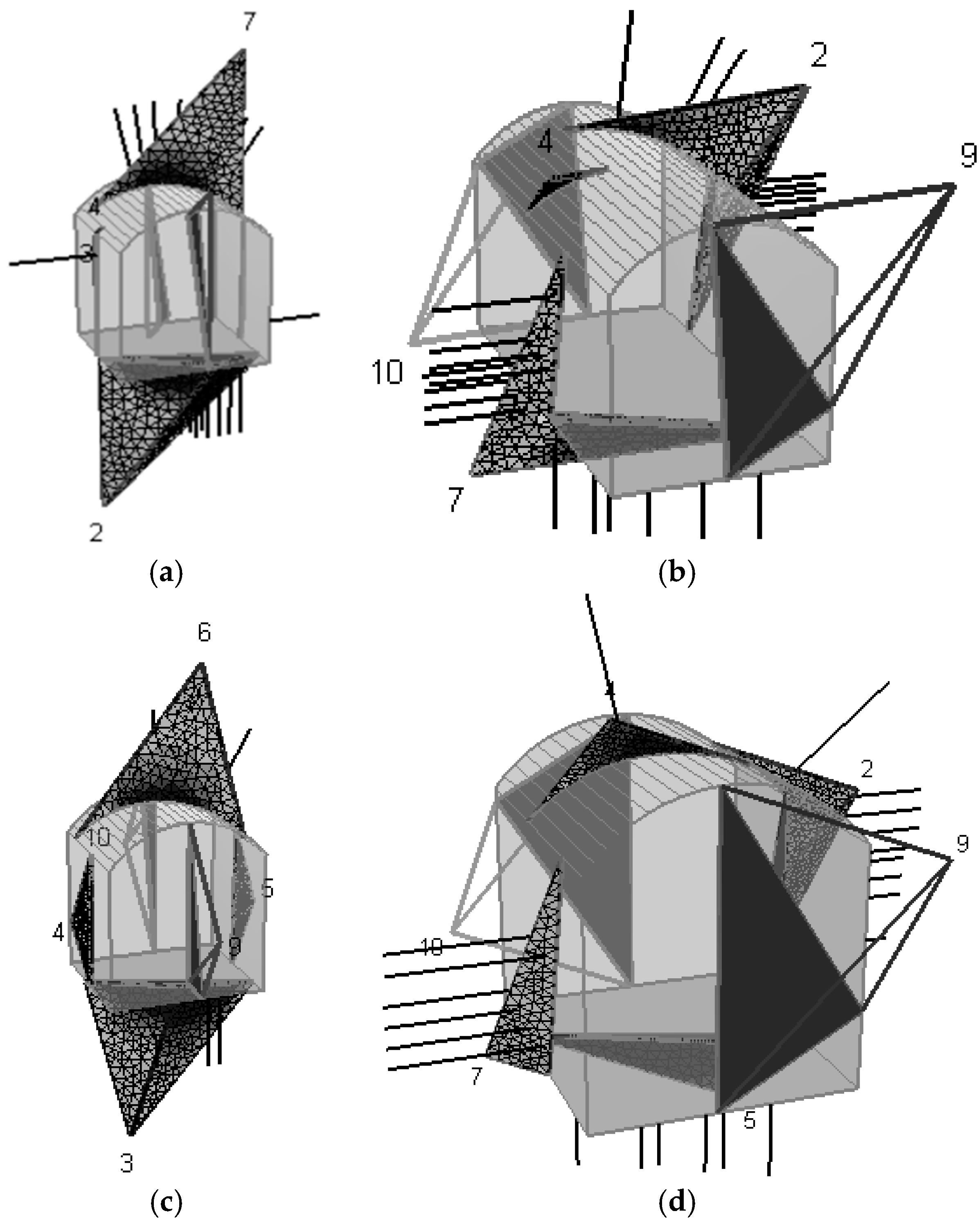
| Group Number | Types of Dip Angle | Occurrences | Trace Length (m) | Spacing (cm) | Percentage (%) |
|---|---|---|---|---|---|
| Jm1 | High dip angle | N80–90° E SE∠85–90° | 2.2–34 | 5–20 | 34 |
| Jm2 | High dip angle | N75–85° E⊥ | 3.1–4.6 | 2–5 | 16 |
| Jm3 | High dip angle | N60–80° E SE∠85–90° | 2.8–5.6 | 2–20 | 23 |
| Jm4 | Medium dip angle | N60–80° E SE∠50–60° | 6.3–8.7 | 5–15 | 36 |
| Jm5 | High dip angle | N30° E⊥ | 6.7–9.6 | 5–30 | 18 |
| Occurrences | Probability Distribution | Mean Value | Standard Deviation |
|---|---|---|---|
| Dip direction (°) | Lognormal | 135.6 | 4.31 |
| Dip angle (°) | Normal | 85.2 | 3.56 |
| Spacing (cm) | Negative exponential distribution | 7.5 | 1.24 |
| Trace length (m) | Normal | 5.7 | 2.03 |
| The Most Critical Dip Direction | Planar Sliding | Unconfined Planar Sliding | Wedge Sliding | Direct Toppling | Flexural Toppling |
|---|---|---|---|---|---|
| Angles | 110–140° | 110–140° | 35–120° | 240–265° | 335–345° |
| Rock Type | Density (kN/m3) | Elastic Modulus (GPa) | Poisson’s Ratio | Uniaxial Compressive Strength (MPa) | Friction Coefficient | Cohesion (MPa) |
|---|---|---|---|---|---|---|
| Rock mass | 25.8–27.4 | 13.2–15.5 | 0.25 | 196–200 | 0.83–0.97 | 0.7–1.0 |
| Structural plane | 24.3–25.6 | 3.2–4.3 | 0.30 | N/A | 0.56–0.64 | 3.5–4.1 |
| ID Number | Safety Factors before Supporting | Required Supporting (kN/m2) | Supporting Force of Rock Bolts and Shotcrete (kN/m2) | Safety Factors after Supporting | Increase Ratio in Safety Factor (%) |
|---|---|---|---|---|---|
| 3204 | 0.86 | 8.46 | 34.27 | 3.49 | 305.28 |
| 3206 | 1.12 | 6.60 | 34.27 | 5.81 | 418.99 |
| 3218 | 0.97 | 5.72 | 34.27 | 5.48 | 498.96 |
| 3216 | 1.41 | 8.10 | 34.27 | 5.97 | 323.34 |
| 3225 | 0.98 | 5.26 | 34.27 | 6.39 | 551.55 |
| 3227 | 1.07 | 10.13 | 34.27 | 3.62 | 238.21 |
| 3229 | 1.11 | 10.46 | 34.27 | 3.64 | 227.74 |
| 3238 | 0.89 | 7.07 | 34.27 | 4.32 | 385.07 |
| 3247 | 1.14 | 10.83 | 34.27 | 3.61 | 216.47 |
| 3250 | 0.96 | 11.84 | 34.27 | 2.78 | 189.48 |
| 3255 | 1.05 | 11.31 | 34.27 | 3.18 | 203.03 |
| 3258 | 0.86 | 9.30 | 34.27 | 3.17 | 268.55 |
| 3269 | 1.18 | 10.86 | 34.27 | 3.72 | 215.61 |
| 3271 | 0.73 | 9.35 | 34.27 | 2.54 | 247.40 |
| 3277 | 1.03 | 7.58 | 34.27 | 3.11 | 202.24 |
| 3283 | 1.14 | 4.59 | 34.27 | 2.25 | 360.78 |
| 3294 | 0.95 | 8.76 | 34.27 | 2.62 | 175.84 |
| 3297 | 1.39 | 7.65 | 34.27 | 6.18 | 345.47 |
© 2017 by the authors. Licensee MDPI, Basel, Switzerland. This article is an open access article distributed under the terms and conditions of the Creative Commons Attribution (CC BY) license (http://creativecommons.org/licenses/by/4.0/).
Share and Cite
Jia, C.; Li, Y.; Lian, M.; Zhou, X. Jointed Surrounding Rock Mass Stability Analysis on an Underground Cavern in a Hydropower Station Based on the Extended Key Block Theory. Energies 2017, 10, 563. https://doi.org/10.3390/en10040563
Jia C, Li Y, Lian M, Zhou X. Jointed Surrounding Rock Mass Stability Analysis on an Underground Cavern in a Hydropower Station Based on the Extended Key Block Theory. Energies. 2017; 10(4):563. https://doi.org/10.3390/en10040563
Chicago/Turabian StyleJia, Chao, Yong Li, Mingyuan Lian, and Xiaoyong Zhou. 2017. "Jointed Surrounding Rock Mass Stability Analysis on an Underground Cavern in a Hydropower Station Based on the Extended Key Block Theory" Energies 10, no. 4: 563. https://doi.org/10.3390/en10040563






